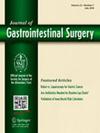Pyloric impedance planimetry during endoscopic per-oral pyloromyotomy guides myotomy extent
IF 2.2
3区 医学
Q3 GASTROENTEROLOGY & HEPATOLOGY
引用次数: 0
Abstract
Background
Per-oral pyloromyotomy (POP), also known as gastric per-oral endoscopic myotomy, is the first-line endoscopic intervention for medically refractory gastroparesis. This study aimed to assess the value of pyloric impedance planimetry using a functional lumen imaging probe (FLIP) during POP.
Methods
Patients who underwent POP between October 2019 and February 2024 were retrospectively reviewed. FLIP measurements, symptoms measured using the Gastroparesis Cardinal Symptom Index (GCSI), and gastric emptying scintigraphy (GES) were evaluated before and after POP.
Results
Of 35 patients who underwent POP, 29 (82.9%) were female, the median age was 51.3 years (IQR, 38.4–60.9), and the median body mass index was 29.26 kg/m2 (IQR, 25.46–32.56). In addition, 23 patients had pre- and post-POP FLIP measurements. The median pyloric diameter increased from 14.4 (IQR, 12.0–16.0) to 16.0 (IQR, 14.8–18.0) mm (S = 116.5; P < .0001). The median distensibility index increased from 4.85 (IQR, 3.38–6.00) to 8.45 (IQR, 5.25–11.00) mm2/mm Hg (S = 112; P < .0001). The management changed based on FLIP values for 5 patients (21.7%), prompting additional myotomy. At 18.0 days (IQR, 12.8–47.8) after the procedure, the median GCSI score decreased from 3.33 (IQR, 2.56–4.12) preoperatively to 2.00 (IQR, 1.00–2.89) postoperatively (S = −193; P < .001). At a median follow-up of 136 days (IQR, 114–277), improvement in GCSI score persisted, with a median score of 2.44 (IQR, 1.44–3.67) (S = −61; P = .021). The median retention at 4 hours on GES decreased from 29.0% (IQR, 16.5–52.0%) to 19.5% (IQR, 5.75–35.30%) at 97 days (IQR, 88–130) after the procedure (S = −108; P = .0038). There was a 75% improvement and a 40% normalization in objective gastric emptying (n = 26). A greater increase in diameter after pyloromyotomy was associated with a greater decrease in 4-hour gastric retention (r = −0.4886; P = .021).
Conclusion
POP with FLIP resulted in clinical and radiographic improvements in patients with gastroparesis. FLIP measurements guided myotomy extent, changing the management in 21.7% of patients, and were associated with gastric emptying, demonstrating its distinct utility in the treatment of gastroparesis.

在内窥镜下进行经口幽门切除术(pop)时,幽门阻抗平面测量可指导肌层切除范围。
背景:经口幽门切开术(POP),又称胃经口幽门切开术(G-POEM),是治疗药物难治性胃瘫的一线内镜干预措施。我们试图评估在 POP 过程中使用功能性管腔成像探头(FLIP)进行幽门阻抗平面测量的价值:回顾性研究了 2019 年 10 月至 2024 年 2 月期间接受 POP 治疗的患者。在 POP 手术前后对 FLIP 测量值、胃瘫主要症状指数(GCSI)测量的症状以及胃排空闪烁成像(GES)进行评估:35名患者(29(82.9%)名女性,51.3(38.4,60.9)岁,体重指数29.26(25.46,32.56kg/m2)接受了POP治疗。23 名患者接受了 POP 前后的 FLIP 测量。中位幽门直径从 14.4(12,16)毫米增至 16(14.8,18)毫米(S=116.5,p2/mmHg(S=112,p)):使用 FLIP 进行 POP 可改善胃瘫患者的临床和影像学状况。FLIP测量结果指导了肌切开术的范围,改变了21.7%患者的治疗方案,并与胃排空相关,证明了其在胃瘫治疗中的独特作用。
本文章由计算机程序翻译,如有差异,请以英文原文为准。
求助全文
约1分钟内获得全文
求助全文
来源期刊
CiteScore
5.50
自引率
3.10%
发文量
319
审稿时长
2 months
期刊介绍:
The Journal of Gastrointestinal Surgery is a scholarly, peer-reviewed journal that updates the surgeon on the latest developments in gastrointestinal surgery. The journal includes original articles on surgery of the digestive tract; gastrointestinal images; "How I Do It" articles, subject reviews, book reports, editorial columns, the SSAT Presidential Address, articles by a guest orator, symposia, letters, results of conferences and more. This is the official publication of the Society for Surgery of the Alimentary Tract. The journal functions as an outstanding forum for continuing education in surgery and diseases of the gastrointestinal tract.

 求助内容:
求助内容: 应助结果提醒方式:
应助结果提醒方式:


